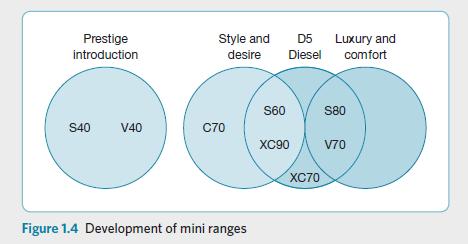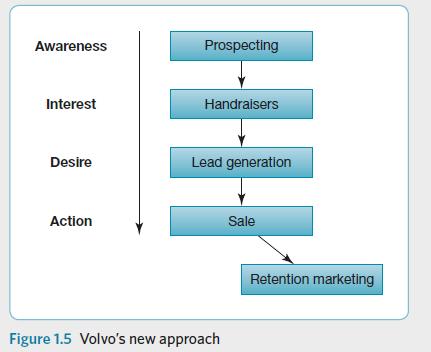The turn of the millennium marked a turning point for Volvo in the UK. The firm decided
Question:
The turn of the millennium marked a turning point for Volvo in the UK. The firm decided it could do better and gave itself a bold new target of increasing sales by 50 per cent within a short time. This was against a backdrop of a decline in the overall market sales within the segment Volvo serves. Volvo was also keen to expand its target audience, and asked EHS Brann to consider ways in which it could tap into fresh consumer segments. Up to that point Volvo’s approach had been primarily product led.
Back in 2000, Volvo’s acquisition strategy was primarily based upon model-specific prospecting. Hence:
‘here’s a car we think you might be interested in . . .’.
However, in order to support the drive for a significant increase in sales, EHS Brann and Volvo realised there was a need for Volvo to differentiate itself from the competition. The challenge was set to find a new way to attract consumers, involve them in the Volvo brand, and ultimately convert them into a sale.
In 2002, the company moved to ‘range based prospecting’.
At that point few people understood Volvo’s range of cars or their naming convention. So there was a need for an education based campaign to increase awareness of the product range.
These campaigns had early success, with a 276 per cent uplift in average response rate across other programmes.
Clearly the company was underselling itself before that point.
But Volvo wanted to keep moving forward. What about segmenting its consumers such that different ranges could be targeted in different ways? This led to its 2003 development of mini ranges ‘prestige introduction’, ‘style and desire’, ‘diesel’ and ‘luxury and comfort’ (see Figure 1.4) and creative work typical of the time, illustrated below.
With good development of general marketing over the 2000–2004 period, it was time to look more closely at Volvo’s direct and Internet marketing. Volvo had always had success in generating lots of ‘handraisers’
 who were aware of Volvo and its cars and may have been interested in them, but Volvo was disappointed with its conversion from direct marketing leads through to test drive and purchase.
who were aware of Volvo and its cars and may have been interested in them, but Volvo was disappointed with its conversion from direct marketing leads through to test drive and purchase.
But why was there low conversion? In those days Volvo would send out as many as 10 million pieces per annum, but these were not particularly targeted, using little more than broad brush age profiles. So, the idea grew to use the ‘science’ of direct marketing to get the percentage of conversions up.
Volvo’s new approach can be summarised as shown in Figure 1. 5.
In the car market, moving with consumers down the AIDA (awareness, interest, desire, action) ladder may take as long as 9–12 months with a car purchase: clearly this is different from more routine purchases.
The year 2004 marked a turning point. With the help of EHS Brann, Volvo decided to develop an even more compelling message by focusing ‘mini’ range communications around consumers rather than cars.

It used the concept of lifestage triggers, well-known key points of consideration for vehicle replacement, with the theme turning subtly from ‘Volvo for life’ into ‘Volvo for YOUR life’.....
Questions
1. What strategic decisions did Volvo make between 2000 and 2008 that have improved its marketing performance?
2. How has direct marketing helped it grow?
3. Looking ahead, how would you assess the growing importance of on‑line marketing?
Step by Step Answer:

Principles Of Direct Database And Digital Marketing
ISBN: 9780273756507
5th Edition
Authors: Alan Tapp





